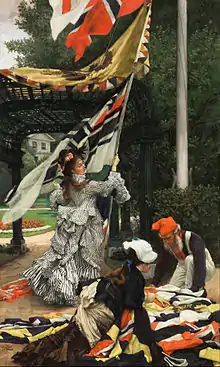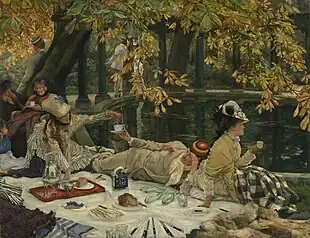James Tissot
Jacques Joseph Tissot (French: [ʒɑk ʒozɛf tiso]; 15 October 1836 – 8 August 1902), better known as James Tissot (/ˈtɪsoʊ/), was a French painter, illustrator, and caricaturist. He was born to a drapery merchant and a milliner and decided to pursue a career in art at a young age, coming to incorporate elements of realism, early Impressionism, and academic art into his work. He is best known for a variety of genre paintings of contemporary European high society produced during the peak of his career, which focused on the people and women's fashion of the Belle Époque and Victorian England, but he would also explore many medieval, biblical, and Japoniste subjects throughout his life. His career included work as a caricaturist for Vanity Fair under the pseudonym of Coïdé.
James Tissot | |
|---|---|
.jpg.webp) Self-Portrait (1865), oil on canvas | |
| Born | Jacques Joseph Tissot 15 October 1836 Nantes, France |
| Died | 8 August 1902 (aged 65) Chenecey-Buillon, France |
| Occupations |
|
Tissot served in the Franco-Prussian War on the side of France and later the Paris Commune before moving to London in 1871, where he would find further success as an artist as well as meet Irishwoman Kathleen Newton, who came to live with him as a close companion and muse until her death in 1882. Tissot maintained close relations with the Impressionist movement for much of his life, including James Abbott Whistler and friend and mentee Edgar Degas. He was awarded the French Legion of Honor in 1894.[1]
Early life
Jacques Tissot was born in the city of Nantes in France and spent his early childhood there. His father, Marcel Théodore Tissot, was a successful drapery merchant. His mother, Marie Durand, assisted her husband in the family business and designed hats. A devout Catholic, Tissot's mother instilled pious devotion in the future artist from a very young age. Tissot's youth spent in Nantes likely contributed to his frequent depiction of shipping vessels and boats in his later works. The involvement of his parents in the fashion industry is believed to have been an influence on his painting style, as he depicted women's clothing in fine detail. By the time Tissot was 17, he knew he wanted to pursue painting as a career. His father opposed this, preferring his son to follow a business profession, but the young Tissot gained his mother's support for his chosen vocation. Around this time, he began using the given name of James as an Anglicisation, becoming commonly known as James Tissot by 1854; he may have adopted it because of his increasing interest in everything English.[1][2]
Artistic debut

In 1856 or 1857, Tissot travelled to Paris to pursue an education in art. While staying with a friend of his mother, painter Jules-Élie Delaunay, Tissot enrolled at the Ecole des Beaux-Arts to study in the studios of Hippolyte Flandrin and Louis Lamothe; Both were successful Lyonnaise painters who moved to Paris to study under Jean-Auguste-Dominique Ingres.[3] Around this time, Tissot also made the acquaintance of the American James McNeill Whistler, and French painters Edgar Degas (who had also been a student of Lamothe and a friend of Delaunay), and Édouard Manet.[1]
In 1859, Tissot exhibited in the Paris Salon for the first time. He showed five paintings of scenes from the Middle Ages, many depicting scenes from Goethe's Faust.[4] These works show the influence in his work of the Belgian painter Henri Leys, whom Tissot had met in Antwerp earlier that same year. Other influences include the works of the German painters Peter von Cornelius and Moritz Retzsch. After Tissot had first exhibited at the Salon and before he had been awarded a medal, the French government paid 5,000 francs for his depiction of The Meeting of Faust and Marguerite in 1860. The painting went on to be exhibited at the Salon the following year, together with a portrait and several other paintings.[1]
Émile Péreire supplied Tissot's painting Walk in the Snow for the 1862 international exhibition in London; the next year three paintings by Tissot were displayed at the gallery of art dealer Ernest Gambart in London.[1]
Mature life and career
Sometime after 1862, Tissot began to shift focus from his early medievalist styles to instead match English tastes for narrative paintings of Victorian life and society.[5] He quickly gained success among British audiences and was lauded for his photorealistic, narrative style of art that combined meticulous training with an impressionistic use of color and value.[5][6] Tissot came to maintain a wide social sphere in light of his success and lifestyle, including Oscar Wilde, James Abbott Whistler, and Edgar Degas.[1][7] Degas shared many of his cultural interests as Tissot's mentee, notably producing a portrait of Tissot in which he is sitting below a Japanese screen hanging on the wall.[8][9]
Tissot led a tumultuous life outside of painting, fighting in the Franco-Prussian War as part of the improvised defence of Paris; First by joining two companies of the Garde Nationale and later as part of the Paris Commune,[10] though he is believed to have only joined the latter to protect his own belongings rather than for shared ideology.[11] Either because of the radical political associations of serving as a Communard or because of better opportunities, he left Paris for London in 1871.[11] Seymour Haden helped him to learn etching techniques during this period.[12]
Having already worked as a caricaturist for Thomas Gibson Bowles, the owner of the magazine Vanity Fair, as well as exhibited at the Royal Academy, Tissot arrived with established social and artistic connections in London.[13][14] Tissot used the name Coïdé in the magazine from 1869 to 1873.[15] Tissot's pre-war caricaturist work with Vanity Fair included contributions to Sovereigns,[14] a series lampooning various heads of state such as Napoleon III of France,[16] Alexander II of Russia,[17] or Wilhelm I of Germany,[18] depicting the latter two in particular as bloodthirsty conquerors.
Post-war career
Tissot would further explore political themes of turmoil in Europe during the onset and aftermath of the war: The 1870 painting La Partie Carrée evoked nostalgia for the period of the French Revolution while hinting at the hedonism of the contemporary French aristocracy in portraying a pair of young women picnicking with two men, one in revolutionary military garb,[3][19] while the c. 1873 work Still on Top depicted the ascension of the Austrian Habsburg and North German war flags over Europe - The title is thought to be an ironic jab at the British ensign barely visible at the top of the canvas.[20] Tissot produced Ball on Shipboard in 1874 with a similar subject, depicting a diverse range of contemporary national flags sewn together in a large awning.[21]
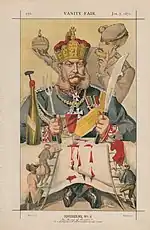
Once established in London, Tissot quickly developed his reputation as a painter of elegantly dressed women shown in scenes of fashionable life. By 1872 Tissot had bought a house in St John's Wood,[22] an area of London very popular with artists at the time. Writer and critic Edmond de Goncourt sarcastically described "a studio with a waiting room where, at all times, there is iced champagne at the disposal of visitors" by 1874.[2] Tissot gained membership of The Arts Club in 1873,[1] and his paintings appealed greatly to wealthy British industrialists throughout the second half of the 19th century. During 1872 he earned 94,515 francs, an income normally only enjoyed by those in the echelons of the upper classes.[1]
Tissot is considered a core figure of Japonisme alongside contemporaries such as Alfred Stevens and Claude Monet,[23] a widespread artistic movement formed in response to the sudden influx of Japanese art, textiles, and curiosities into the European market as a result of the forced opening of trade relations with Japan in 1853 and subsequent Meiji Restoration in 1868.[24][25] Printed Japanese art emphasized clarity, spaciousness, and boldness appealing to the Ukiyo urban culture and Tissot came to regularly include popular Japanese artifacts and costumes in his pictures after being introduced to the subject by Whistler,[26] additionally expressing stylistic influences in his use of composition and perspective.[27][23][24]
In 1874, Degas asked him to join them in the first exhibition organized by the artists who became known as the Impressionists, a then-nascent artistic movement that would inspire much of Tissot's own style. Tissot ultimately refused but would remain a close acquaintance of the group.[5][28] Berthe Morisot visited him in London in 1874, and he travelled to Venice with Édouard Manet at about the same time. He regularly saw Whistler, who influenced Tissot's Thames river scenes.[1]
A strong recurring theme throughout Tissot's middle career was the exploration of social and sexual tension between men and women in the context of strictly gender-segregated Victorian society.[22][29][30] Many of his depictions of contemporary life include hints or narratives of desire, vulgarity, and the complexity of sexual relationships,[20] while his idiosyncratic focus on women's fashion and society made an idealized female beauty a widespread commonality of his portraiture. Gallery of HMS 'Calcutta' (1876) was particularly noted for its use of body language and subtext in depicting a scandalous moment of flirtation between a married officer and a young woman, the perspective heavily accentuating the latter's figure and sexuality,[29][31] and received criticism as "hard, vulgar, and banal" upon release.[32] Some scholars have even suggested Tissot's selection of the Calcutta as the painting's setting to be a deliberate play on the phrase "Quel cul tu as" ("What an arse you have" in French).[31][33] Portsmouth Dockyard, an 1877 variation on a painting titled On The Thames (How Happy I Could Be with Either?), received similar accusations of immorality for its ambiguous depiction of what its predecessor's alternative title reveals to be a military man openly deciding between two potential suitresses.[34]
Family life and bereavement
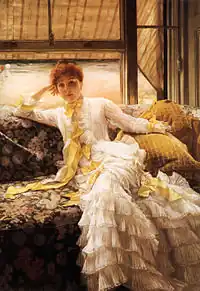
In 1875 or 1876, Tissot met Kathleen Newton, an Irish divorcee who became the painter's companion and frequent sitter. She quickly began an intimate relationship with Tissot, moving in as a housemate in 1877. The couple's marital status was uncertain, as Tissot's Catholic faith did not recognize her divorce and meant they could not opt for annulment without delegitimizing her previous children, however they chose to live openly as husband and wife and their servants addressed Newton as "Madame Tissot". Newton is said to have called Tissot "Jimmie", whilst his pet names for her included "Kitty", "Petit Femme", and "Mavourneen" (an Irish term after "Kathleen Mavourneen", a popular love song from the time).[7] Newton gave birth to a son named Cecil George Newton in 1876, who is believed to be Tissot's, and the couple would frequently entertain her previous children at Tissot's property even while they continued to live with her relatives. Later, Tissot often referred to these years with Newton as the happiest of his life, a time when he was able to live out his dream of being a family man.[7][11]
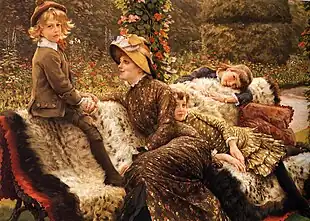
Newton's work as a sitter for Tissot encompassed dozens of paintings and studies, most notably including a well-known 1876 etching entitled Portrait of Mrs N., more commonly titled La Frileuse,[1] which was later the basis for the 1877 painting Mavourneen, also known as A Portrait or as Winter.[35] Tissot's paintings and prints of 1877–1881 included images of travel along the Thames or south coast and to Paris, but many focused on Newton relaxing and reading in the garden, or surrounded by visiting children. Around 1880–1881 she contracted consumption and Tissot portrayed her sitting well-wrapped outdoors, as fresh air was thought to have a curing effect. Newton succumbed to her illness in Tissot's arms on 9 November 1882, "with the ardent faith of a neophyte and the silent resignation of a saint."[36]
After Kathleen Newton's death, Tissot returned to Paris. The last major exhibition of this era in Tissot's life took place in 1885, with a 15-painting series titled Quinze Tableau sur la Femme à Paris (Fifteen Paintings on the Woman of Paris), displayed at the Galerie Sedelmeyer.[37] Unlike the genre scenes of fashionable women he painted in London, these paintings sought to represent different archetypes of women across many different classes and occupations, shown in professional and social scenes.[1] The Shop Girl in particular seemed to return to Tissot's exploration of sexuality and gender, with one writer identifying depictions of desire and baseness in the composition, while the series's wider inclusion of working class women outside of the household as subjects could have been seen as morally dubious at the time.[30] La Femme à Paris also solidified the influence of Japanese prints in Tissot's work, as he used unexpected angles and framing from that tradition to create a monumental context in the size of the canvases.[23]
- La Femme à Paris
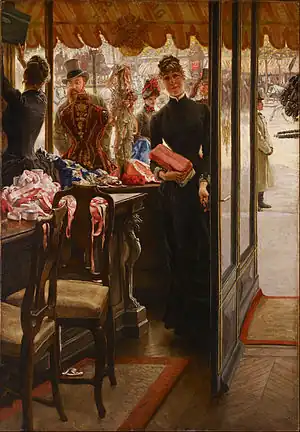 The Shop Girl, c. 1878–1885
The Shop Girl, c. 1878–1885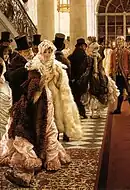 The Woman of Fashion, c. 1883–1885
The Woman of Fashion, c. 1883–1885 The Ladies of the Cars, c. 1883–1885
The Ladies of the Cars, c. 1883–1885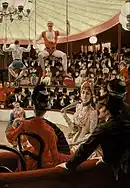 The Circus Lover, 1885
The Circus Lover, 1885 A Woman of Ambition, 1885
A Woman of Ambition, 1885
Late career

After completing the Woman of Paris in 1885 Tissot experienced a religious vision at the Church of St. Sulpice, leading him to revive his Catholic faith and spend the remainder of his life making paintings about biblical events.[38] Moving away from the Impressionists' and Post-Impressionists' intent to create art that reflected a changing, modern world,[39] Tissot returned to traditional, representational styles and narratives in his watercolors. As part of this artistic effort Tissot traveled to the Middle East in 1886, 1889, and 1896 to make studies of its landscapes and cultures, which would come to distinguish his series from contemporary Biblical art through its "considerable archaeological exactitude"[38] in striving for accuracy rather than religious emotion.[12] His series of 365 gouache illustrations showing the life of Christ were shown to critical acclaim and enthusiastic audiences in Paris (1894–1895), London (1896) and New York (1898–1899), before being bought by the Brooklyn Museum in 1900.[38] They were published in a French edition in 1896–1897 and in an English one in 1897–1898, bringing Tissot vast wealth and fame. During July 1894, Tissot was awarded the Legion of Honour, France's most prestigious medal.[1]
Tissot spent the last years of his life working on paintings of subjects from the Old Testament.[40] Although he never completed the series, he exhibited 80 of these paintings in Paris in 1901 and engravings after them were published in 1904.[11]
- The Life of Christ
_-_James_Tissot_-_overall.jpg.webp)
_-_James_Tissot.jpg.webp)
_-_James_Tissot.jpg.webp) Our Lord Jesus Christ
Our Lord Jesus Christ_-_James_Tissot.jpg.webp)
_-_James_Tissot.jpg.webp)
- Subjects from the Old Testament
 The Creation, Jewish Museum (New York), c. 1896–1902
The Creation, Jewish Museum (New York), c. 1896–1902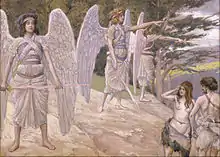 Adam and Eve Driven From Paradise, c. 1896–1902
Adam and Eve Driven From Paradise, c. 1896–1902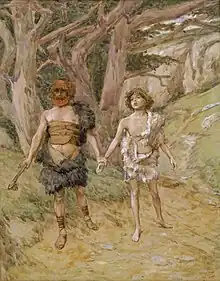 Cain leadeth Abel to death, c. 1900
Cain leadeth Abel to death, c. 1900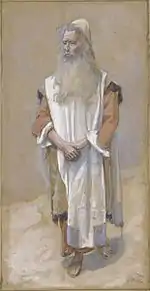 Moses, watercolor c. 1896–1902
Moses, watercolor c. 1896–1902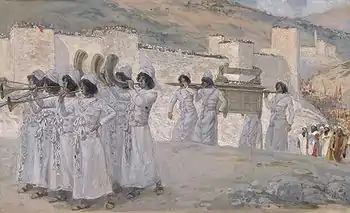 The Seven Trumpets of Jericho, c. 1896–1902
The Seven Trumpets of Jericho, c. 1896–1902
Death and legacy
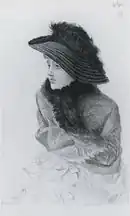

Tissot died suddenly in Doubs, France, on 8 August 1902, while living in the Château de Buillon, a former abbey which he had inherited from his father in 1888. His grave is in the chapel sited within the grounds of the chateau.[1][11]
Widespread use of his illustrations in literature and slides continued after his death with The Life of Christ and The Old Testament becoming the "definitive Bible images". In 1906, filmmaker Alice Guy-Blaché used the Tissot Bible as the basis for The Birth, the Life and the Death of Christ, her largest production at Gaumont to date featuring approximately three hundred extras over twenty-five total episodes.[41][42] Though the financial success of his contemporary subjects originally did little to dissuade derision of his mundane, photorealistic style, with Oscar Wilde criticizing his "hard unscrupulousness in painting uninteresting objects in an uninteresting way,"[43] the first half of the 20th century saw a re-kindling of interest in his portraits of fashionable ladies and some fifty years later, these were achieving high prices.[1] La Frileuse and his other etchings would also be brought back out of obscurity by reinvigorated critical interest from the 1920s onward.[44] His images provided a foundation for contemporary films such as the twin-angel prop design for the Ark of the Covenant in Raiders of the Lost Ark (1981) and lifestyle themes in The Age of Innocence (1993). In 2000 English Victorian art writer Christopher Wood described Tissot as "the greatest painter of social life in Victorian times".[45]
See also
References
Citations
- Matyjaszkiewicz, Krystyna (2011). "Tissot, Jacques Joseph (1836–1902)". Oxford Dictionary of National Biography (online ed.). Oxford University Press. doi:10.1093/ref:odnb/68966. Retrieved 5 July 2014. (Subscription or UK public library membership required.)
- Oxford Dictionary of Art and Artists, Artist Profile Summary, via artuk.org, Retrieved 26 May 2023
- Anabelle Kienle Poňka, The Frivolity of the Directoire Period: James Tissot's "Partie Carrée", National Gallery of Canada magazine, 9 April 2020. Retrieved 28 May 2023
- Kleinschmidt, Beda. "James Tissot." The Catholic Encyclopedia. Vol. 14. New York: Robert Appleton Company, 1912. http://www.newadvent.org/cathen/14741a.htm Retrieved 27 May 2023
- William H. Robinson, Paul J. and Edith Ingalls Vignos Jr. Senior, James Tissot, Painter of Modern Life. Cleveland Museum of Art, via Medium, 24 February 2023. Retrieved 28 May 2023.
- “While our industrial and artistic creations may perish, and our customs and our costumes may fall into oblivion, a painting by Mr. Tissot will be enough for archaeologists of the future to reconstruct our era.” Élie Roy, “Salon de 1869,” L’Artiste 40 (July 1869), 82.
- Ross, Marita, “The Truth About Tissot,” Everybody’s, 15 June 1946, p. 6.
- "Portrait of James-Jacques-Joseph Tissot".
- Metropolitan Museum of Art. "Edgar Degas, James-Jacques-Joseph Tissot (1836–1902) ca. 1867–68". metmuseum.org. Retrieved 18 June 2022.
- Tillier, Bertrand, “Tissot and the Traumas of the ‘Terrible Year’” in Buron, Melissa E. (ed.), James Tissot. San Francisco: Fine Arts Museums of San Francisco/DelMonico Books-Prestel, 2019.
- Misfeldt, Willard E., "Tissot, James", Oxford Art Online, Oxford University Press, retrieved 5 July 2014
- Chisholm, Hugh, ed. (1911). . Encyclopædia Britannica. Vol. 26 (11th ed.). Cambridge University Press. pp. 1015–1016. Retrieved 26 May 2023
- "James Tissot: Tea (1998.170) – Heilbrunn Timeline of Art History". The Metropolitan Museum of Art. Retrieved 27 May 2023
- Roy T. Matthews; Peter Mellini (1982). In "Vanity Fair". University of California Press. p. 32. ISBN 978-0-85967-597-0. Retrieved 27 May 2023
- "Coïdé". ChrisBeetles.com. Retrieved 26 May 2023
- Yale, Napoleon III, YCBA online collection, Retrieved 26 May 2023
- National Portrait Gallery, Alexander II, Emperor of Russia, Reference Collection Search, Retrieved 26 May 2023
- National Portrait Gallery, Wilhelm I, Emperor of Germany and King of Prussia, Reference Collection Search, Retrieved 26 May 2023
- "Acquisitions of the month: December 2018". Apollo Magazine. 11 January 2019.
- The Auckland Art Gallery Toi o Tāmaki Guide, 2001, https://www.aucklandartgallery.com/explore-art-and-ideas/artwork/436/still-on-top?q=%2Fexplore-art-and-ideas%2Fartwork%2F436%2Fstill-on-top Retrieved 14 May 2023
- Tate Catalogue Entry, https://www.tate.org.uk/art/artworks/tissot-the-ball-on-shipboard-n04892 Retrieved 26 May 2023
- "Abstract: French artist James Tissot moved to London in 1871; soon after his arrival, he set up house in fashionable St. John's Wood... Tissot's representations of this space reveal that the Victorian plant conservatory was a particularly complex site wherein contemporary ideas—and, more often, anxieties—about the intersections among sex, race, health, science, and empire came into contact in complicated and often contradictory ways..." Burton, Samantha. “Champagne in the Shrubbery: Sex, Science, and Space in James Tissot’s London Conservatory.” Victorian Studies, vol. 57, no. 3, 2015, pp. 476–89. JSTOR, https://doi.org/10.2979/victorianstudies.57.3.476. Accessed 27 May 2023.
- By Jules Claretie in his book L'Art français en 1872 and by Philippe Burty (1830–1890) in Japonisme III: La Renaissance littéraire et artistique
- Ono 2003, p. 1
- Bickford, Lawrence (1993). "Ukiyo-e Print History". Impressions (17): 1. JSTOR 42597774.
- James McNeill Whistler, Caprice en violet et or : le paravent doré, 1864, Washington, Freer Gallery of Art.
- Britannica, The Editors of Encyclopaedia. "Japanism". Encyclopedia Britannica, https://www.britannica.com/art/Japanism. Accessed 14 May 2023.
- Metropolitan Museum of Art. "Edgar Degas, James-Jacques-Joseph Tissot (1836–1902) ca. 1867–68". metmuseum.org. Retrieved 18 June 2022.
- "The Gallery of HMS Calcutta (Portsmouth), c.1876". Tate. Retrieved 15 May 2023
- Regina Haggo. The Hamilton Spectator. 26 September 2006. pg. G.11
- Jérôme Coignard, Valérie Bougault, La Galerie du HMS Calcutta par James Tissot : focus sur un chef-d’œuvre, Conaissance des Arts, https://www.connaissancedesarts.com/musees/musee-orsay/la-galerie-du-hms-calcutta-portsmouth-par-james-tissot-focus-sur-un-chef-doeuvre-11136146/ Retrieved 15 May 2023
- Hughes (2001), 17
- Marshall, Nancy Rose. James Tissot: Victorian Life, Modern Love. Malcolm Warner, pp.85-87
- Tate, Gallery label, July 2007 https://www.tate.org.uk/art/artworks/tissot-portsmouth-dockyard-n05302 Retrieved 15 May 2023
- Matyjaszkiewicz, Krystyna, “73 / ‘Winter’ or ‘Mavourneen’” in “Catalogue Checklist”, Buron 2019, p. 294.
- Bastard 1906, p. 264: “cette belle créature expira dans ses bras . . . Avant s’éteindre, gagnée par les croyances de son fidèle ami, elle embrassa la religion catholique et rendit le dernier soupir avec la foi ardente d’une néophyte la résignation muette d’une sainte.”
- "Review: James Tissot. New Haven, Québec and Buffalo," by Paul Stirton. The Burlington Magazine 2000 pg. 131.
- Brooklyn Museum. "James Tissot". Retrieved 3 May 2011.
- Samu, Margaret. "Impressionism: Art and Modernity". metmuseum.org. Retrieved 13 June 2022.
- Jewish Museum. "James Tissot". Archived from the original on 18 September 2012.
- Richard Abel, The Cine Goes to Town: French Cinema, 1896-1914, University of California Press, 1998, pp. 20 and 165.
- Alison McMahan, Alice Guy Blaché: Lost Visionary of the Cinema, Bloomsbury Publishing USA, 2014, p. 28.
- Oscar Wilde, The Grosvenor Gallery, Dublin University Magazine, July 1877. Transcribed from the 1908 edition of Miscellanies by David Price, 16 November 2004, Project Gutenberg. Retrieved 15 May 2023
- Wentworth, Michael. "Fourteen Etchings by J.J. Tissot". The Massachusetts Review, vol. 9, no. 3, 1968, pp. 505–28. JSTOR, http://www.jstor.org/stable/25087742. Accessed 1 June 2023.
- Victorian Painting by Christopher Wood. Bulfinch Press. 2000
General sources
- This article incorporates text from a publication now in the public domain: Chisholm, Hugh, ed. (1911). "Tissot, James Joseph Jacques". Encyclopædia Britannica. Vol. 26 (11th ed.). Cambridge University Press.
- Misfeldt, Willard E. "Tissot, James [Jacques-Joseph]" in Oxford Art Online.
- Biography of Tissot with recent information on Kathleen Newton at Paul Ripley's Victorian Art in Britain
- Ono, Ayako (2003). Japonisme in Britain: Whistler, Menpes, Henry, Hornel and nineteenth-century Japan. New York: Routledge Curzon.
- Wentworth, Michael. "James Tissot". Oxford: Clarendon Press, 1984. Print
- Wood, Christopher. "Tissot: Life and Work of Jacques Joseph Tissot 1836–1902". London: Weidenfeld and Nicolson, 1986. Print.
External links
- 209 works by James Tissot at JamesTissot.org
- James Tissot: The Life of Christ: Exhibition at Brooklyn Museum 2009 (Archived 5 September 2009 at the Wayback Machine)
- Commentary on Tissot's etching of Kathleen Newton
- Commentary on a portrait of Mrs. Newton
- Zimmer, Bill (31 October 1999). "Art; Love and History, Lavishly Elegant". The New York Times. Retrieved 6 August 2008.
- Biblical art by James Tissot
- Degas: The Artist's Mind, exhibition catalog from The Metropolitan Museum of Art fully available online as PDF, which contains material on James Tissot (see index)
